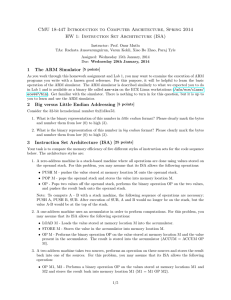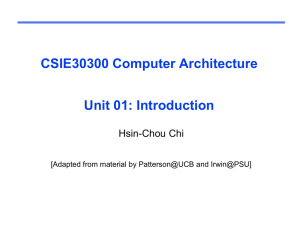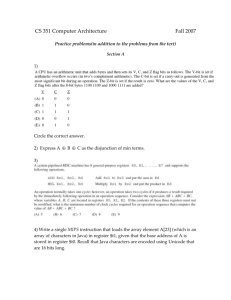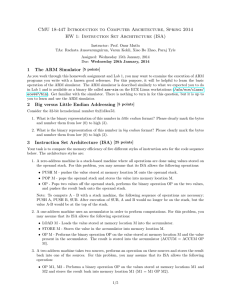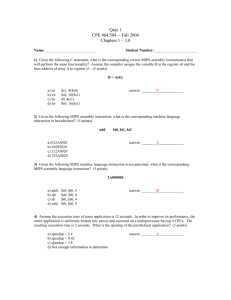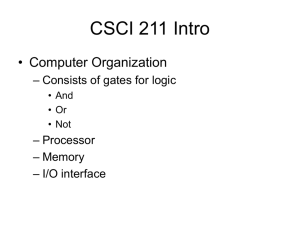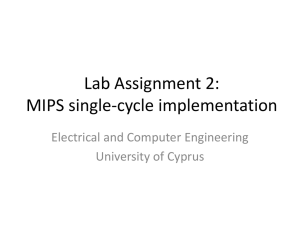CMU 18-447 Introduction to Computer Architecture, Spring 2013
advertisement
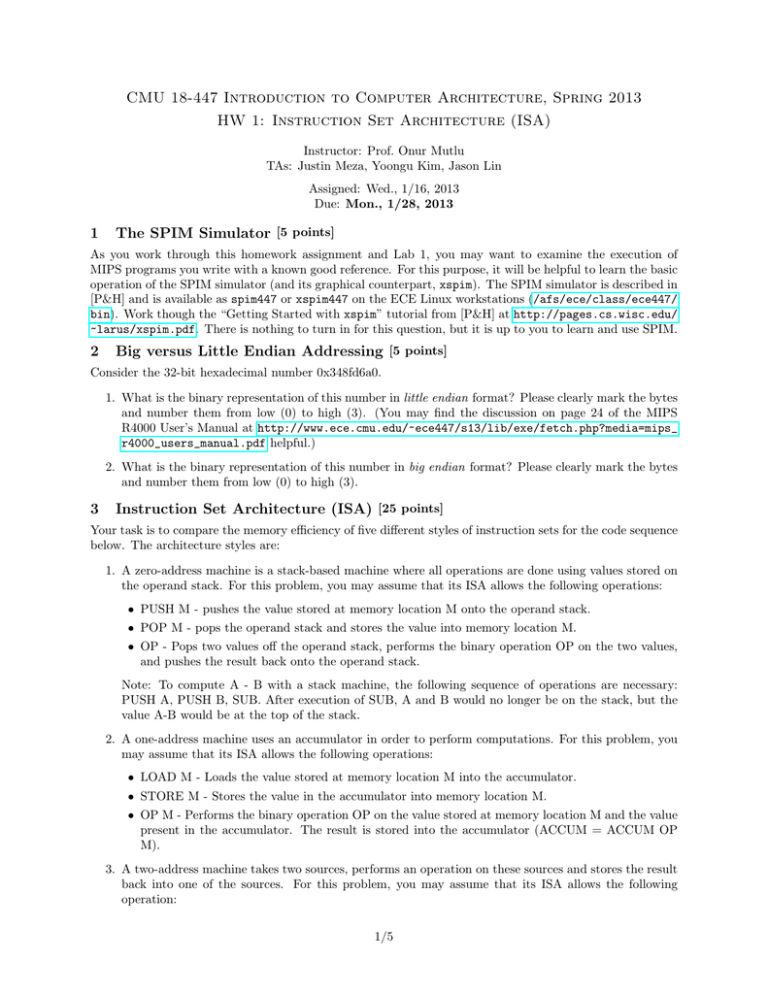
CMU 18-447 Introduction to Computer Architecture, Spring 2013
HW 1: Instruction Set Architecture (ISA)
Instructor: Prof. Onur Mutlu
TAs: Justin Meza, Yoongu Kim, Jason Lin
Assigned: Wed., 1/16, 2013
Due: Mon., 1/28, 2013
1
The SPIM Simulator [5 points]
As you work through this homework assignment and Lab 1, you may want to examine the execution of
MIPS programs you write with a known good reference. For this purpose, it will be helpful to learn the basic
operation of the SPIM simulator (and its graphical counterpart, xspim). The SPIM simulator is described in
[P&H] and is available as spim447 or xspim447 on the ECE Linux workstations (/afs/ece/class/ece447/
bin). Work though the “Getting Started with xspim” tutorial from [P&H] at http://pages.cs.wisc.edu/
~larus/xspim.pdf. There is nothing to turn in for this question, but it is up to you to learn and use SPIM.
2
Big versus Little Endian Addressing [5 points]
Consider the 32-bit hexadecimal number 0x348fd6a0.
1. What is the binary representation of this number in little endian format? Please clearly mark the bytes
and number them from low (0) to high (3). (You may find the discussion on page 24 of the MIPS
R4000 User’s Manual at http://www.ece.cmu.edu/~ece447/s13/lib/exe/fetch.php?media=mips_
r4000_users_manual.pdf helpful.)
2. What is the binary representation of this number in big endian format? Please clearly mark the bytes
and number them from low (0) to high (3).
3
Instruction Set Architecture (ISA) [25 points]
Your task is to compare the memory efficiency of five different styles of instruction sets for the code sequence
below. The architecture styles are:
1. A zero-address machine is a stack-based machine where all operations are done using values stored on
the operand stack. For this problem, you may assume that its ISA allows the following operations:
• PUSH M - pushes the value stored at memory location M onto the operand stack.
• POP M - pops the operand stack and stores the value into memory location M.
• OP - Pops two values off the operand stack, performs the binary operation OP on the two values,
and pushes the result back onto the operand stack.
Note: To compute A - B with a stack machine, the following sequence of operations are necessary:
PUSH A, PUSH B, SUB. After execution of SUB, A and B would no longer be on the stack, but the
value A-B would be at the top of the stack.
2. A one-address machine uses an accumulator in order to perform computations. For this problem, you
may assume that its ISA allows the following operations:
• LOAD M - Loads the value stored at memory location M into the accumulator.
• STORE M - Stores the value in the accumulator into memory location M.
• OP M - Performs the binary operation OP on the value stored at memory location M and the value
present in the accumulator. The result is stored into the accumulator (ACCUM = ACCUM OP
M).
3. A two-address machine takes two sources, performs an operation on these sources and stores the result
back into one of the sources. For this problem, you may assume that its ISA allows the following
operation:
1/5
• OP M1, M2 - Performs a binary operation OP on the values stored at memory locations M1 and
M2 and stores the result back into memory location M1 (M1 = M1 OP M2).
4. A three-address machine, in general takes two sources, performs an operation and stores the result
back into a destination different from either of the sources.
Consider
(a) A three-address memory-memory machine whose sources and destination are memory locations.
For this problem, you may assume that its ISA allows the following operation:
• OP M3, M1, M2 - Performs a binary operation OP on the values stored at memory locations
M1 and M2 and stores the result back into memory location M3 (M3 = M1 OP M2).
(b) A three-address load-store machine whose sources and destination are registers. Values are loaded
into registers using memory operations (The MIPS is an example of a three-address load-store
machine). For this problem, you may assume that its ISA allows the following operations:
• OP R3, R1, R2 - Performs a binary operation OP on the values stored at registers R1 and R2
and stores the result back into register R3 (R3 = R1 OP R2).
• LD R1, M - Loads the value at memory location M into register R1.
• ST R2, M - Stores the value in register R2 into memory location M.
To measure memory efficiency, make the following assumptions about all five instruction sets:
• The opcode is always 1 byte (8 bits).
• All register operands are 1 byte (8 bits).
• All memory addresses are 2 bytes (16 bits).
• All data operands are 4 bytes (32 bits).
• All instructions are an integral number of bytes in length.
There are no other optimizations to reduce memory traffic, and the variables A, B, C, and D are initially
in memory.
(a) Write the code sequences for the following high-level language fragment for each of the five architecture
styles. Be sure to store the contents of A, B, and D back into memory, but do not modify any other
values in memory.
A = B + C;
B = A + C;
D = A - B;
(b) Calculate the instruction bytes fetched and the memory-data bytes transferred (read or written) for each
of the five architecture styles.
(c) Which architecture is most efficient as measured by code size?
(d) Which architecture is most efficient as measured by total memory bandwidth required (code+data)?
4
4.1
The MIPS ISA [40 points]
Warmup: Computing a Fibonacci Number [15 points]
The Fibonacci number Fn is recursively defined as
F (n) = F (n − 1) + F (n − 2),
where F (1) = 1 and F (2) = 1. So, F (3) = F (2) + F (1) = 1 + 1 = 2, and so on. Write the MIPS assembly
for the fib(n) function, which computes the Fibonacci number F (n):
2/5
int fib(int n)
{
int a = 0;
int b = 1;
int c = a + b;
while (n > 1) {
c = a + b;
a = b;
b = c;
n--;
}
return c;
}
Remember to follow MIPS register usage convention (just for your reference, you may not need to use
all of these registers):
• The argument n is passed in register $4.
• The result should be returned in $2.
• $8 to $15 are caller-saved temporary registers.
• $16 to $23 are callee-saved temporary registers.
• $29 is the stack pointer register.
• $31 stores the return address.
A summary of the MIPS ISA is provided at the end of this handout, and a MIPS reference sheet is on the wiki
at http://www.ece.cmu.edu/~ece447/s13/lib/exe/fetch.php?media=mips_reference_data.pdf. The
MIPS architecture reference manual is also on the wiki at http://www.ece.cmu.edu/~ece447/s13/lib/
exe/fetch.php?media=mips_r4000_users_manual.pdf.
4.2
MIPS Assembly for REP MOVSB [25 points]
Recall from lecture that MIPS is a Reduced Instruction Set Computing (RISC) ISA. Complex Instruction
Set Computing (CISC) ISAs—such as Intel’s x86—often use one instruction to perform the function of many
instructions in a RISC ISA. Here you will implement the MIPS equivalent for a single Intel x86 instruction,
REP MOVSB, which we will specify here.1
The REP MOVSB instruction uses three fixed x86 registers: ECX (count), ESI (source), and EDI
(destination). The “repeat” (REP) prefix on the instruction indicates that it will repeat ECX times. Each
iteration, it moves one byte from memory at address ESI to memory at address EDI, and then increments
both pointers by one. Thus, the instruction copies ECX bytes from address ESI to address EDI.
(a) Write the corresponding assembly code in MIPS ISA that accomplishes the same function as this instruction. You can use any general purpose register. Indicate which MIPS registers you have chosen to
correspond to the x86 registers used by REP MOVSB. Try to minimize code size as much as possible.
(b) What is the size of the MIPS assembly code you wrote in (a), in bytes? How does it compare to REP
MOVSB in x86 (note: REP MOVSB occupies 2 bytes)?
(c) Assume the contents of the x86 register file are as follows before the execution of the REP MOVSB:
EAX: 0xccccaaaa
EBP: 0x00002222
ECX: 0xdeadbeef
1 The REP MOVSB instruction is actually more complex than what we describe. For those who are interested, the Intel
architecture manual (found on the wiki at http://www.ece.cmu.edu/~ece447/s13/doku.php?id=manuals) describes the MOVSB
instruction on page 1327 and the REP prefix on page 1682. We are assuming a 32-bit protected mode environment with flat
addressing (no segmentation), and a direction flag set to zero. You do not need to worry about these details to complete the
homework problem.
3/5
EDX:
ESI:
EDI:
EBP:
ESP:
0xfeed4444
0xdecaffff
0xdeaddeed
0xe0000000
0xe0000000
Now, consider the MIPS assembly code you wrote in (a). How many total instructions will be executed
by your code to accomplish the same fuction as the single REP MOVSB in x86 accomplishes for the
given register state?
(d) Assume the contents of the x86 register file are as follows before the execution of the REP MOVSB:
EAX:
EBP:
ECX:
EDX:
ESI:
EDI:
EBP:
ESP:
0xccccaaaa
0x00002222
0x01000000
0xfeed4444
0xdecaffff
0xdeaddeed
0xe0000000
0xe0000000
Now, answer the same question in (c) for the above register values.
5
Data Flow Programs [15 points]
Draw the data flow graph for the fib(n) function from Question 4.1. You may use the following data flow
nodes in your graph:
• + (addition)
• > (left operand is greater than right operand)
• Copy (copy the value on the input to both outputs)
• BR (branch, with the semantics discussed in class, label the True and False outputs)
Clearly label all the nodes, program inputs, and program outputs. Try to the use fewest number of data
flow nodes possible.
6
Performance Metrics [10 points]
• If a given program runs on a processor with a higher frequency, does it imply that the processor always
executes more instructions per second (compared to a processor with a lower frequency)? (Use less than
10 words.)
• If a processor executes more of a given program’s instructions per second, does it imply that the processor
always finishes the program faster (compared to a processor that executes fewer instructions per second)?
(Use less than 10 words.)
7
Performance Evaluation [15 points]
Your job is to evaluate the potential performance of two processors, each implementing a different ISA. The
evaluation is based on its performance on a particular benchmark. On the processor implementing ISA A,
the best compiled code for this benchmark performs at the rate of 10 IPC. That processor has a 500 MHz
clock. On the processor implementing ISA B, the best compiled code for this benchmark performs at the
rate of 2 IPC. That processor has a 600 MHz clock.
• What is the performance in Millions of Instructions per Second (MIPS) of the processor implementing
ISA A?
• What is the performance in MIPS of the processor implementing ISA B?
• Which is the higher performance processor:
A
Briefly explain your answer.
4/5
B
Don’t know
MIPS Instruction Summary
Opcode
Example Assembly
Semantics
add
add $1, $2, $3
$1 = $2 + $3
sub
sub $1, $2, $3
$1 = $2 - $3
add immediate
addi $1, $2, 100
$1 = $2 + 100
add unsigned
addu $1, $2, $3
$1 = $2 + $3
subtract unsigned
subu $1, $2, $3
$1 = $2 - $3
add immediate unsigned
addiu $1, $2, 100
$1 = $2 + 100
multiply
mult $2, $3
hi, lo = $2 * $3
multiply unsigned
multu $2, $3
hi, lo = $2 * $3
divide
div $2, $3
lo = $2/$3, hi = $2 mod $3
divide unsigned
divu $2, $3
lo = $2/$3, hi = $2 mod $3
move from hi
mfhi $1
$1 = hi
move from low
mflo $1
$1 = lo
and
and $1, $2, $3
$1 = $2 & $3
or
or $1, $2, $3
$1 = $2 | $3
and immediate
andi $1, $2, 100
$1 = $2 & 100
or immediate
ori $1, $2, 100
$1 = $2 | 100
shift left logical
sll $1, $2, 10
$1 = $2 << 10
shift right logical
srl $1, $2, 10
$1 = $2 >> 10
load word
lw $1, 100($2)
$1 = memory[$2 + 100]
store word
sw $1, 100($2)
memory[$2 + 100] = $1
load upper immediate
lui $1, 100
$1 = 100 << 16
branch on equal
beq $1, $2, label
if ($1 == $2) goto label
branch on not equal
bne $1, $2, label
if ($1 != $2) goto label
set on less than
slt $1, $2, $3
if ($2 < $3) $1 = 1 else $1 = 0
set on less than immediate
slti $1, $2, 100
if ($2 < 100) $1 = 1 else $1 = 0
set on less than unsigned
sltu $1, $2, $3
if ($2 < $3) $1 = 1 else $1 = 0
set on less than immediate
sltui $1, $2, 100
if ($2 < 100) $1 = 1 else $1 = 0
jump
j label
goto label
jump register
jr $31
goto $31
jump and link
jal label
$31 = PC + 4; goto label
5/5




